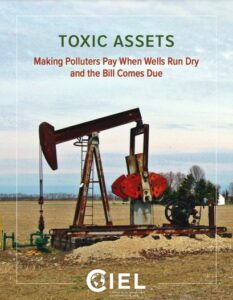
As the fossil fuel era faces its necessary and inevitable end, several questions loom large: When the oil and gas stop flowing, what will happen to the millions of wells drilled onshore and offshore, the pipelines and plants that transport and process the fuels, and the lands and waters where they sit? Who pays the cost of closing down and cleaning up extraction sites or remediating the significant health and environmental impacts of production? What legal obligations do public and private actors have to protect local communities from the toxic legacy of oil and gas production?
Toxic Assets: Making Polluters Pay When Wells Run Dry and the Bill Comes Due explores the fast-approaching post-production phase of the oil and gas lifecycle. As the fossil fuel industry sunsets, the world must confront the industry’s toxic legacy and take urgent action to ensure the cleanup costs fall on companies, not communities. The report begins by exposing the structural flaws in legal and regulatory frameworks that have created these unfunded environmental liabilities through a close look at problems with planning and financing for well closure in the United States and Canada. It then makes recommendations about what is needed to mitigate the resultant harms to public health and the public purse and ensure that polluters pay. Finally, it cautions those countries contemplating starting up oil and gas operations today to think hard about the costs associated with shutting them down tomorrow.
Read the full, designed report here.
Table of Contents
Executive Summary
Key Findings
Introduction: The Accelerating Problems of Closure & Cleanup
Part 1: The Oil and Gas Industry Pollutes from Beyond the Grave
Part 2: Polluters Should (But Often Don’t) Pay
Text Box 2: Requirements Under International Human Rights and Environmental Law
Text Box 3: Alternative Approaches to Financial Assurance
Long Plugging Timelines: Keeping Options Open or Kicking the Can?
Inadequate Financial Security for Closure and Cleanup Costs
Part 3: COVID Relief Becomes Corporate Relief
Case Studies: North Dakota and Alberta
Part 4: Decommissioning Costs Pose a Material Risk to Companies (and Their Financial Backers)
Part 5: Orphan Wells: A Global Problem
Text Box 4: Uncovering the Costs of Unconventional Drilling
Text Box 5: Guyana: In Deep Water
Conclusion
Recommendations
Endnotes
Published April 2021
